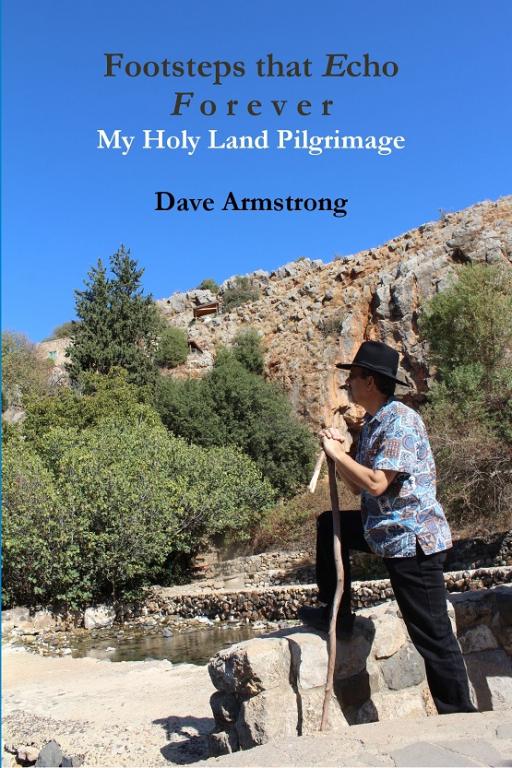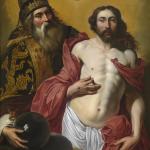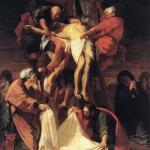
[from my 2014 book, Footsteps that Echo Forever: My Holy Land Pilgrimage]
*****
Day Nine: 26 October [2014] [Church of the Holy Sepulchre]
After the first night in our hotel in Jerusalem (with some delightful fun walking the nearby streets after the Sabbath ended, for a pizza), we set out in the morning to the Church of the Holy Sepulchre: using a map that we had in a free pamphlet. It was a very interesting walk: passing through the New Gate into the Old City of Jerusalem.
The streets there are unlike anything I have seen in America. They are almost more tunnels than streets, or a sort of unending shopping mall with old brick walls. The colors of the products in the innumerable shops (especially the Middle Eastern women’s clothes, with their endless intricate and gorgeous designs) dazzle the eyes.
The merchants usually sit by the street and try to entice customers, but not nearly as abrasively and straightforwardly as the notorious street peddlers in Israel (who must be ignored with a polite “no thank you” and no eye contact). One such young man (on one of our later Old City excursions) sort of grabbed my arm and said “Yes!” I said, just as firmly, “No!” and walked on without missing a step. We chuckled quite a bit over that.
We managed to find the church and walked through the door to another world: more like heaven than anywhere I’ve ever been. The first thing that caught my attention was the Gregorian chant going on in the distance and the huge scale of the often castle-like church. with many huge pillars. I looked up to see an enormous dome. With incense (never seeming more like the prayer it represents than at this moment) ascending to its top. Once again the Holy Spirit was palpable.
The first thing we saw was a slab of rock in front of the door. This was where the body of Jesus was laid and anointed after His crucifixion. To the immediate right was an old staircase which said “Golgotha.” Judy and I immediately ascended and then saw the area (which I had seen in photos before) where our Lord was crucified: dying for our sins and redeeming us, provided that we accept His free gift of grace and persevere in that grace until death.
We both got that same feeling we had had in several holy places on the pilgrimage, of being overwhelmed by the Holy Spirit and a tangible sensation of being physically weak and helpless. My heart was pounding in anticipation. Judy was already crying and completely overcome. We waited about fifteen minutes in line and noted how everyone knelt under the altar and were able to touch the actual whitish rock of Golgotha underneath it, through a hole.
I have used the metaphor of “spiritual electricity” more than once in this book. Here that feeling of power and God’s presence was exponentially magnified all the more so: like being in the center of the sun (if indeed that were possible). The feeling of awe and reverence is simply indescribable and beyond all words (yet we inadequately try to convey it, anyway).
This must have been what it felt like for the high priests to enter the Holy of Holies in the tabernacle and temple. This was the location of the cross! After hearing about it thousands of times in sermons and other talks and in my reading, here I was, at the actual site where Jesus died for me!
Judy and I decided to bow under the altar together, to worship Jesus, whose birthplace we had visited the day before. We touched our wedding rings to the rock underneath, as well as six other items: small crosses and other things made from olive wood in Bethlehem: four of them now extraordinary third-class relics and “souvenirs” for our four children.
Judy wanted to go to a semi-private place, so we did so for another 10-15 minutes or so. I kept gazing at a large mural in front of us: of Jesus being crucified, taken down, and rising again: realizing that all of that happened in the very church where we were standing.
Soon we were in line to the tomb where Jesus’ body was laid, and where He rose from the dead. Needless to say, it was equally moving and “soul-shattering.” We knelt for a few moments before what appeared to be a marble slab of rock. I laid my arms all over it. I had now been to the two sites which are the epicenter of the Christian universe, and in fact, of the universe, period. I’ll never be the same again.
Elsewhere in the church we saw two pillars where Jesus was scourged: one able to be touched. We also visited St. Helena’s chapel, on a lower level, where she found the true cross, and another side-chapel directly underneath Golgotha, where Adam was supposed to have been buried, and where a visible crack in the rock of Golgotha was visible:
Matthew 27:50-54 And Jesus cried again with a loud voice and yielded up his spirit. [51] And behold, the curtain of the temple was torn in two, from top to bottom; and the earth shook, and the rocks were split; [52] the tombs also were opened, and many bodies of the saints who had fallen asleep were raised, [53] and coming out of the tombs after his resurrection they went into the holy city and appeared to many. [54] When the centurion and those who were with him, keeping watch over Jesus, saw the earthquake and what took place, they were filled with awe, and said, “Truly this was the Son of God!”
Another spot marked the location of the women who were with Jesus during His passion on the cross, including His mother (Mt 27:55-56; Jn 19:25-27). Lastly, we went to Mass at the location where Mary Magdalene saw the risen Jesus. We thought the Mass was in Russian the whole time. It turned out to be in Polish. We also observed a portion of an Orthodox Divine Liturgy in what I thought was the most beautiful portion of the church.
Judy and I made our way through the Old City afterward: mostly in the Christian and Jewish quarters, and a little bit of the Armenian. It’s a “maze” even with a map, but truly a walking adventure. We saw a portion of an old city wall that existed in the time of Jesus, and which He walked through (I believe) carrying His cross at the old Gennath (Garden) Gate.
We also got one great view of the Dome of the Rock and the Mount of Olives, as well as a section of old wall dating to about 700 B.C. We then departed from the Old City, through the Jaffa Gate and followed the wall a ways south, locating the “pavement” (“Gabbatha”: Jn 19:13) where Jesus was judged by Pontius Pilate, with the people yelling out, “Crucify Him.” Since no one seems to be aware of this new “theory” in archaeology, we were the only ones there. Yet this is a site (if this view is correct) as holy as the pillars where our Lord was scourged.
Along the walls, we observed older portions from the time of Jesus. Much of the lower portion of the walls that surround the city (built by Muslims in the 16th century), are Herodian walls or even earlier walls from the Hasmonean period (c. 140 – 37 B. C.). The Muslims simply built on top of what was there.
In our hotel room later that night, Margie and Judy again recounted the amazing spiritual experiences of the day. Margie provided a quite remarkable and stunning narrative:
In the courtyard I was so stunned at that point emotionally that from that point on it was almost surreal. I knew I was on holy ground. The next 3-4 hours after entering that door was the most powerful spiritual experience of my life to this day. I had studied the Holy Sepulchre; where all the locations were, so I knew where I was at. But I forgot it all. There were only two things that my senses could comprehend: the chanting and the smell of the holy oil. It was like smelling Jesus. The chanting was like heaven. It bothered me that people were talking. I didn’t speak a word for three hours.
I was almost in a panic, thinking, “where’s the cross?” I was standing in line for the tomb, and I was literally sobbing, almost to the point where I couldn’t breathe. I was shaking, and the closer I got to the tomb, the stronger it became. It was so overwhelming that I felt I had to hold something, as if, if I didn’t hold on to something, I would have died from the power. So I held on to an olive wood cross, and it was like a relief: the only thing holding me from being obliterated from the power. It was crazy! I’ve never gone through this!
If someone in the field of archaeology had said this wasn’t the place, I would have said they are wrong, because there is no way I could have had an experience like that. When I got there and knelt down, all I could feel was power; almost like you couldn’t take it. I didn’t think I would even be able to stand up.
Then I knew I had to find the cross, and I found it and went up there, and I got to a painting of Jesus being nailed to the cross, and I started to feel suffering. Then I saw the shrine of the sorrowful mother, and again, the closer I got, the more power I felt. I was weak, shaking, and sobbing, and felt a sorrow, suffering, and joy all at the same time. I wanted it to stop, but I didn’t want it to, because I was so close to Jesus. So it was worth it. Then I had to sit in a chair, because I couldn’t take it any more. I sat there and had to sob for a while before I could go on. I couldn’t control myself. Then I saw the slab where Christ was anointed after being taken down and I needed a place to collapse because I wanted to be with Jesus alone. I knelt down and just collapsed on it, and it was an experience so mystical that I can’t adequately put it into words; but I’ll try.
It was a great relief to be able to just sob. I don’t know how long I was there. It was like time stopped, and it seemed like me and Jesus, and we were extremely close. I was afraid the moment would go away. My husband Paul said I was there for 30 minutes. I felt a small part of how Mary suffered. And if I had had one more ounce of it, I would have died. It was suffering mingled with joy. Then I got to a point where I was calmed and started to feel peace, so that I could get up again. I still couldn’t talk.
The whole thing changed me in a very big way, but I can’t explain how. Something happened very big spiritually, to my soul, and I can’t put it into words. but I know I’m different. There was definitely some healing going on, that only He knows that I need; that He knows, and I don’t know.
Later I went to the Wailing Wall and I saw the Jews praying and the Muslim prayer call came on, and I thought, “my God, they have no idea of what happened over at the Holy Sepulchre: how Jesus saved them.” Then I felt sorry that Jesus was rejected by them.
Judy’s “testimony” was scarcely less extraordinary:
When we were walking there, I was thinking, “what if nothing happens?” But as soon as we hit the courtyard, my knees became weak. Then we went to the anointing slab I immediately had to kneel down, and I was caressing the stone and thanking my Lord for all that He has done for me. It was a time of thanksgiving. Then when we went up the stairs to Golgotha, that was unbelievable. I felt a crushing weight on my shoulders, and my whole body felt crushed, like what Jesus would have felt. It took every ounce of my being to walk up those stairs. Dave and I and Margie experienced a lot of common things. When we got to the top of the stairs, I literally felt that my heart was ripped in two. When we were waiting in line and saw the image of the crucifixion, and when we knelt under the altar, then I felt a little piece of what Mary felt and I thought, “I can’t take this.” I could visually see her weeping and trying to comfort her Son, and I wanted to do that, too. I thought of Joseph, as a quiet observer, taking it all in. His pain was just as real for him as Mary’s, but he was taking it in inwardly.
But when we knelt under the altar I felt a piercing that just gripped me. I was crying so hard and I wanted the tears to land on Jesus to soothe Him [Dave: Margie reported the same feeling at the anointing slab]. I sat on a chair nearby and wanted to just scream out in agony, so in order to avoid that I wanted to be by ourselves. And when we were by ourselves, that’s when I was able to let it out in tears.
When I first got to the tomb, I was caressing it and felt like I was wiping the blood and sweat off of Him, and cradling Him. I felt like I laid Him down. I put my arms out and a total pain went through my body that felt like an electrical shock, and it felt like I was burning.
When we went to the chapel of St. Helena, where she found the cross, I walked into that room, not knowing what it was, and it was like a magnet pulling my knees to the ground at the altar. I couldn’t get up. I thought that this experience had to confirm the authenticity of the holy place. I never felt anything like that in my life. I was so scared that I thought I was gonna die in that particular place.
We went to a Mass in Polish, and I recognized the priest saying “Mary Magdalene,” telling the story and a rush of joy came over me, like when she comes to the tomb and she sees Jesus, and running back with such joy to tell the apostles, “He’s risen.” Then when we did the mea culpa I felt like someone was pounding on my heart. At the Holy Holy Holy I wanted to drop to my knees, and I couldn’t even say that. At Holy Communion I received the gift of tears: tears of joy about all that He had done for me; but tears of sorrow for people who don’t get what Jesus has done for them.
Margie’s husband Paul came over to our room and made an important point about how he (and we agreed, many men) don’t need to feel these extraordinary degrees of emotion in order to believe something in the area of religious belief. He said “I believe” (referring to Catholic doctrines) and that such outpourings of emotion simply weren’t necessary for him.
I could relate to that as a man because I was commenting to Judy and Margie after interviewing them for this section, about how I marveled that Judy felt all these things and I felt almost none of them, or if I did, it was in a very different way.
But men often feel things at a deeper level (for them) that is not as outwardly emotional or expressive but still just as real. And Judy agreed that such powerful emotions were not necessary to “prove” that one believes in Catholic doctrine.
In their own way, Paul’s experience today, and mine and Ross’s, may not have been as nearly “dramatic” and expressive as the two women’s experiences (and make for much less compelling reading), but it doesn’t follow that they were any less powerful or life-changing. They just were in a different way. Another way to put it is that spiritual power is not the equivalent of emotional power. They surely overlap, but they aren’t the same thing.
I think that in this as in many areas, God made men and women complementary to each other. All that said, I do love and admire how women typically experience such spiritual things as those we have met with on this pilgrimage. Perhaps we men would “die” if we felt what they described. Women seem to have a capacity to endure more pain than men do: more empathy and sympathy. I’ve always thought that these were some of their finest qualities.
***
(originally 10-26-14)
***













